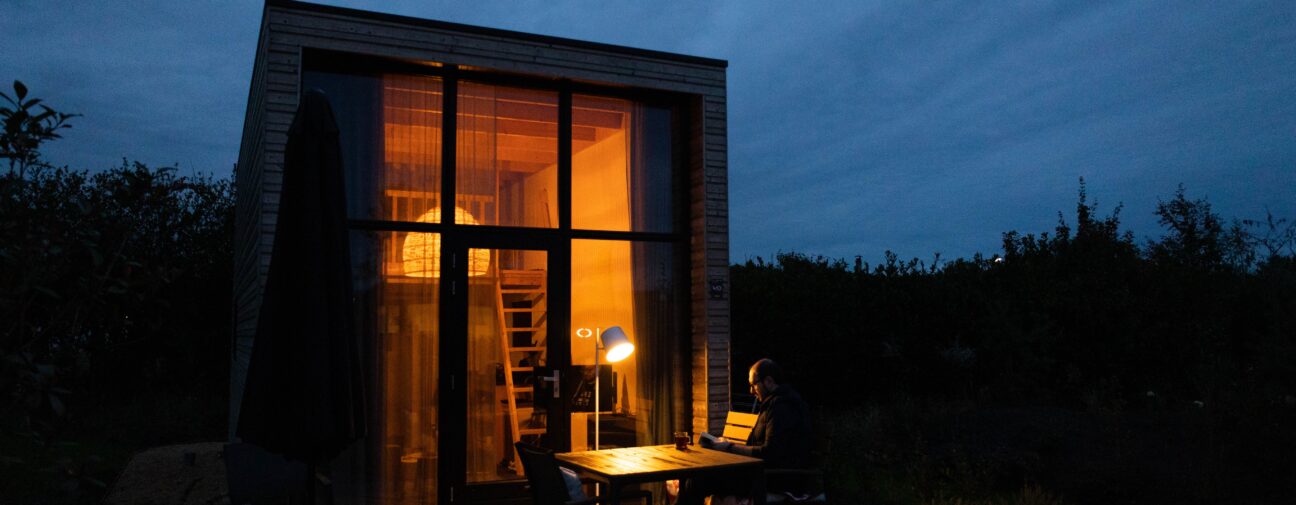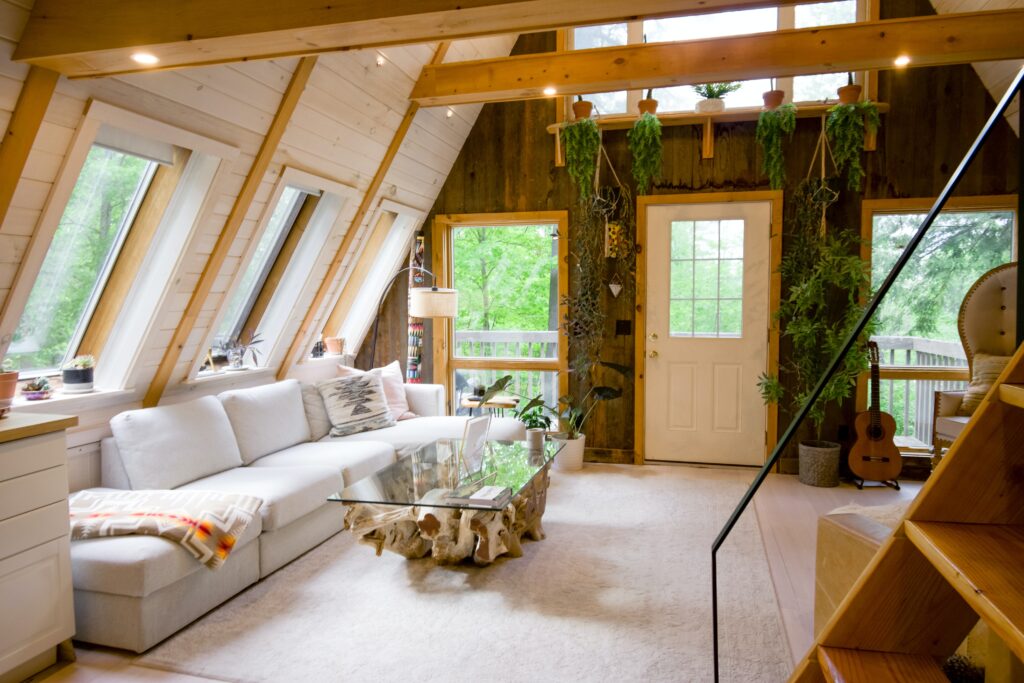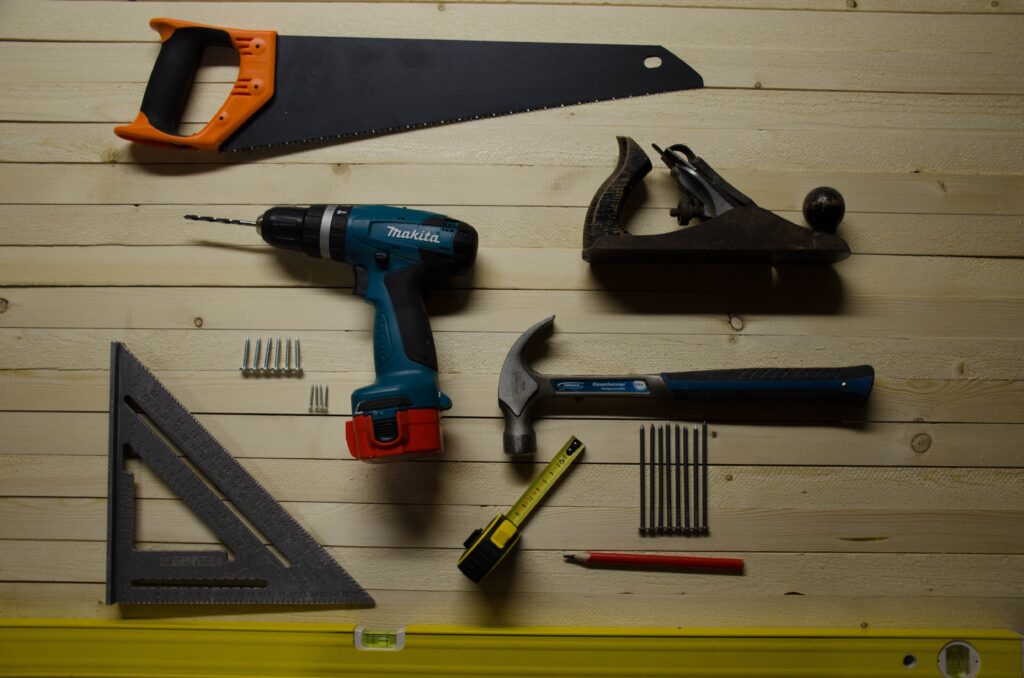Blog
Quick Guide To Tiny House Framing

Are you considering building a tiny home? Or are you trying to figure out how to frame a tiny house? Constructing a small house is not as hard as it seems. With the right tools, equipment, and some patience, you can have your own tiny home up in less than three days!
Framing is a term in construction that refers to arranging and joining materials to create a structure. In the case of a tiny house, this usually means using dimensional studs to frame your walls.
The Four Components of Framing
Framing is typically broken down into various tasks:
Framing the Floor System
In a tiny house, the floor system is typically made from treated lumber or sometimes cedar, but treated pine can be used as well. The floor joists are attached to the rim joist, and then a plywood subfloor is installed.
Some people also frame a small storage area under the main section of their floor system that they call a “tumble up.” This is often done when building on a trailer or uneven surface where an open crawl space is not ideal.
Framing the Walls
Studs are the members of the structure that form its vertical supports. They hold up your roof sheathing and subfloor, as well as your wall cladding (brick veneer, stucco, siding, etc.).
Studs are usually 2x4s or 2x6s but can range from 1-1/2″ x 3-1/2″, to 2″ x 4″, to even more prominent in some cases.
Roof Framing
The rafters should be installed on top of the walls before the next step to level each other. If you have trusses instead of rafters, you will attach them now if they are not pre-assembled.
The Rafters
The rafter ties your top plate and your roof sheathing together, so it is crucial that they not be installed more than 1/2″ out of plumb (perpendicular to the ground).
Placing them too far out of plumb makes the roofless structurally sound. However, this is mitigated somewhat by shimming them until they are straight.
Keep in mind that you will still need to check the angle on each end and make sure it is fastened tightly to prevent tearing or splitting. It’s also helpful if someone helps hold them in place while you install any interior blocking.
If you build with trusses, make sure you install rafters on both sides of the trusses. Trusses are the only proven method to create a structure that can span up to 20+ feet.
If you’re building with trusses, make sure you install rafters on both sides of the trusses. This is important for two reasons:
- It provides additional support
- It ensures you have proper ventilation under your roof.

Four Material Options for Tiny House Framing
Four material framing options provide the most versatility when it comes to building tiny houses. And each of these materials has its own advantages and disadvantages.
1. Steel
Steel framing is the most expensive material option but also one of the strongest. It is highly durable and will last longer than other framing materials.
Tiny houses built with steel frames can be easily moved from place to place without compromising their structural integrity.
Steel frames are also fire-resistant and can stay perfectly straight, ensuring that your construction will remain consistent and tall. It is also easy to use as a foundation as well as having the ability to be finished with insulation, drywall, and other materials.
Tiny house frames have the additional benefit of being endlessly recyclable, which is ideal for the eco-conscious small house inhabitant.
2. Wood
Wood framing is probably not your first option for a tiny home. However, they provide the next best strength-to-cost ratio among your framing options.
It is easy to work with, widely available, and inexpensive compared to all other framing options. Wood framing expands and contracts due to temperature variations which can cause it to fall out of the square over time.
Basic carpentry skills are needed for wood construction, but no special tools are required (although you might want a nail gun)
The top reason to use wood for your tiny home framing construction is if you’re still undecided about your design. It’s easy to modify or replace the wood framework if anything goes wrong.
The whole procedure will require a lot of measuring and cutting, but the final product and savings could be worthwhile in the long run.
3. Hybrid
The next best choice in framing materials is old-fashioned timber combined with pre-cut lumber. These methods can be complicated because it requires building a post and beam structure then attaching the structural members later.
However, hybrid framing for tiny houses often combines the strength and lightness of steel with the warmth of wood. You can have the best of the two.
Hybrid construction can start with a steel frame with columns supporting the roof, then be stabilized by adding wood walls in between.
Screw cladding onto the steel sections and have design freedom with the frame. Not only can hybrid construction help keep costs down, but it can also save weight over all-steel construction.
4. Structural Insulated Panels
Insulated panels of various thicknesses provide a quick and efficient way to build.
These can be made from polystyrene insulation (extruded like drywall) or expanded polystyrene beads (similar to beadboard).
The panels are light, make the wall cavity airtight and add structural strength. This method lends itself well to factory-built walls delivered on-site for assembly.
Planning to build using structural insulated panels (SIPs) requires extensive preparation. Plumbing and electricity wiring should be considered since they are inconvenient to install without confined spaces.

Eight Primary Tools and Equipment You’ll Need When Framing Your Tiny House
1. Tape Measure
It is the most common and essential measuring tool in tiny house framing.
Are you looking for the perfect tape measure? Well, Stanley Hand Tools PowerLock Tape Measure is your go-to solution. It features a durable and robust blade, an industrial-grade end hook, and a comfortable grip.
- Tape Measures. Quantity Per Case: 1.
2. Cordless Drill
This allows you to drive screws in and out of wood quickly. Consider getting one with a variable speed for greater control and a lower risk of stripping or harming screw heads.
Want to buy the best cordless drills on the market? Buy DEWALT 20V Max Cordless Drill Combo Kit on Amazon, and you’ll get what you pay for!
- DCD771 in cordless drill combo kit features 2 speed transmission (0-450 / 0-1500 RPM)
- DCD771 high performance motor of cordless tools combo kit delivers 300 unit watts out (UWO) of power ability completing a wide range of applications
- DCD771 compact, lightweight design of the drill/ impact driver combo kit fits into tight areas
- DCD771 1/2-inch single sleeve ratcheting chuck provides tight bit gripping strength
- DCD771 Ergonomic handle delivers comfort and control
- DCF885 Compact (5.55-inch front to back), lightweight (2.8 lbs) design fits into tight areas
- DCF885 1-handed loading 1/4-inch hex chuck accepts 1-inch bit tips
- DCF885 features 3 LED light ring withe 20 second delay to provide visibility without shad
3. Speed Square
It will help you with your cutting works, especially for 45-degree angles where a standard tape measure is not long enough to read interior angles accurately.
Get only the finest speed square tool at Amazon – where you can get the best price!
- MULTIPLE GRADATIONS: Gradations included for marking common, hip, Valley, and jack rafters. Useful for determining and marking angles and making square cuts on boards.
- FEATURES: Get more bang for your buck with this value pack of two of our best selling speed squares
- DURABLE MATERIAL: Heavy-gauge billet aluminum alloy construction is die-cast for increased accuracy versus laser-etched and extruded stamped rafter squares.
- EASY TO USE: When used as a saw guide, the speed square makes truing up a board easy
- CLEARLY IDENTIFIABLE SCALE: High-visibility, black gradations with a non-glare, matte finish for easy reading in any lighting conditi
4. Utility Knife
This inexpensive tool is used constantly when framing, such as making starter furring strip openings in the wall sheathing.
You can shop for premium utility knives on Amazon. Check out Sheffield 12115 Ultimate Lock Back Utility Knife. And see why so many people are raving about this product!
- PATENTED QUICK-CHANGE BLADE MECHANISM: Nothing to unscrew when installing new folding box cutter blades, setting it apart from every other cardboard cutter out there
- LOCK BACK RELEASE: Box knife features the same lock back release as your favorite Sheffield pocket knives, keeping your blade safely in place when opened or closed
- CLASSIC LOOK: This is not your average box blade; Our razor knife features the classical stylings of a wood-grain and aluminum handle
- POWERFUL WORK KNIFE: Our box cutters are more than just box cutters; Cut carpet, paper, rope, rubber hoses, PVC, leather, fabric, Sheetrock, and so much more; These are the most practical utility knives for most any task
- FOLDING UTILITY KNIFE FULL SPECS: 6 inches open length, 3-1/2 inches closed length, patented quick-change blade mechanism, lock back design, thumb stud, textured aluminum grip, uses standard utility blades, features pocket c
5. Circular Saw
An electric circular saw with a 5- to 6-inch blade is probably all you need for most of your cutting. But consider including a 10-inch blade if you think you might need it for some big timbers. All blades should be carbide-tipped or better. You can also rent circular saws.
SKIL 5280-01 Circular Saw is one of the most popular circular saws on Amazon. It is very powerful and affordable.
- Powerful 15-amp motor delivers 5,300-RPM for greater speed and faster cuts
- 7-1,4-inch carbide-tipped blade included. Spindle lock for easy blade changes.
- 51 degree bevel capacity for a wide variety of cuts. Arbor size: 5,8 inches, cord length: 6 feet
- Lightweight 6.95-pounds design reduces fatigue
- Dust blower keeps line-of-cut free of sawdust for improved visibility. Anti-snag lower guard reduces snags when making narrow cut-o
6. Hammer and Framing Nails
These tools must be on your list. You will need it to secure the studs to each other and into the plywood. Do not use finishing nails.
Buy a high-class framing hammer and nails with unique features at Amazon today!
- HIGH-CLASS MATERIALS – The 560Pcs hardware nails are all made from heavy-duty carbon steel and double galvanized for better anti-corrosive and anti-rust performance. The 16oz claw hammer consists of a hammer head forged of strong and robust carbon steel and a soft anti-slip TPR handle. The metal part of the hammer is specially processed to be rust-proof and durable, it is built to last tens of years.
- PRACTICAL ORGANIZER & ERGONOMIC HANDLE – The nail assortment kit comes with a high-quality plastic organizer with 8 compartments for the 8 different nail types and sizes. Made of premium TPU, the handle of the Claw hammer is ergonomically designed and provides comfortable gripping experience. Hammer handle Fiberglass construction absorbs vibration and reduces fatigue.
- RATIONAL SIZE ASSORTMENT – You will receive 560pcs nails of different sizes and types: there are 280pcs galvanized picture hanging nails and 280pcs galvanized finishing headless nails in 0.75in,1in,1.18in,1-1/2in sizes. The 16oz Claw hammer included in this set has excellent performance in various projects, like woodwork, household repair, and construction.
- FOR ALL KINDS OF PROJECTS – With our high-quality claw hammer & hardware nails assortment set, you can easily handle various projects with confidence, such as hanging pictures, photos, installing curtain rods, door and window frames and more. The robust and durable nail tool kit with organizer is also a great gift for dad, boyfriend, kids, husband for their DIY projects.
- WHAT YOU GET – There are 560pcs anti-corrosive galvanized hardware nails, 1pc precision-machined 16oz claw hammer and 1pc 6.4×4.4×1.1 plastic organizer in the package. This nail tool kit also comes with an 1-month free-return & refund service, proving you with satisfactory customer service and worry-free shopping experien
7. Beam Level
The beam level comes in standard 8-foot lengths. Use it to monitor plumb, level, and square on framing assemblies.
For a high-quality and durable beam-level tool at a great price, check out this product from Amazon.
- Highly durable
- Easy to use
- Manufactured in China
- Laser Class Illa, Power output ≤5mW
- Laser Class Illa, Power output ≤
8. Quick-Grip Clamps
These are the “C-clamps” of framing. These allow you to hold the wood in place while you nail it, but they take some practice and muscle to tighten them down.
Need to buy some clamps for your framing project? Don’t fret! IRWIN QUICK-GRIP Clamps Set is your way to go!
- Mini Bar clamps exert up to 150 psi. of clamping pressure
- Handi-Clamps feature QUICK-RELEASE triggers for fast and easy positioning
- All clamps constructed of high-tech reinforced resin for strength and durability
- Backed by the IRWIN Lifet
In addition, when framing your tiny house, don’t forget to wear protective gear. Safety goggles are essential to protect your eyes from flying debris. A dust mask is also good if you’ll be cutting fiberboard or material that kicks up a lot of dust.
Earmuffs are great on construction sites but not needed on the worksite on your land. If you are nailing more than three sheets of plywood, you might also want to wear rubber gloves.
Some Final Words
Framing is a method of building that uses dimensional lumber cut into studs, rafters, joists, and other structural pieces to support your home’s walls, ceilings, and floors.
The choice you make about which type of framing to use will have a significant impact on the actual design of your tiny house as well as how easy it is to build!







